ANSWERS TO THE TOP SEVEN CARPENTER ANT QUESTIONS
By Chris Williams on May 16, 2019.
When carpenter ants are found inside a home or other structure, they can be just visitors that are foraging for food, which they are taking back to an outdoor nest, or they can be residents living in your home and chewing on your wood. How can you tell what’s what? Carpenter ant inspection and control can be relatively simple and straightforward or much more complex. That’s where you need the services of a pest control professional who can answer your questions.
1. HOW DO WE KNOW IF WE HAVE CARPENTER ANTS?
Listed below are the most common signs of a carpenter ant infestation. Not all signs may be noticed and some may not appear until a colony is many years old and damage is extensive. Certain other wood-destroying insects have similar signs so a professional inspection is important:
- Many foraging ants inside
- Flying or crawling winged ants
- Sawdust-like “dump piles”
- Noises from infested wood
- Hollow-sounding or mushy wood
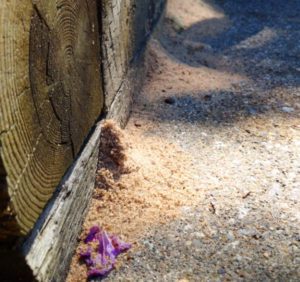
Carpenter Ant “frass” outside of a nest in a landscape log. Z. Ciras
If carpenter ants are nesting in your home, you may see worker ants following trails along baseboards or other edges looking for crumbs and other food. Sometimes you can follow these trailing ants back to a nest site or to a ground floor door where they entered from outside. In the best case scenario, the ants may just be randomly looking for food from an outside nest and found a convenient entrance to your home, around a garage door, for example. If you find foraging carpenter ants inside during the dead of winter, however, assume that they are also nesting inside since outside colonies are inactive at that time. Note: Not all foraging ants are carpenter ants, most invading ants will follow trails.
If ants are nesting inside, once the colony grows to a certain size (3-6 years old), it will produce winged reproductives (queens and kings) whose purpose is to disperse, mate, shed their wings, and establish new colonies in the ground. When they find themselves inside instead, these reproductives will head for windows and other light sources where you may later find discarded wings and even dead ants. Note: Other types of indoor-nesting ants can also produce winged reproductives, as can termites.
Often, the first sign of carpenter ants nesting in wood is a small pile of what appears to be sawdust found directly under the nest site. These “dump piles” are more than just excavated wood, however. The ants’ sawdust piles can be differentiated from some other wood-boring insects’ sawdust because the ants’ piles also contain debris cleared from the nest: bits of soil or insulation, seed coats, indigestible parts of their insect prey, and even dead carpenter ants.
The dump is pushed out of the nest through a crevice or a small slit called a “window” that the ants cut into the wood. But sometimes the slit may be on the backside of a piece of wood and the dump pile could end up in a less visible place like a wall void, instead.
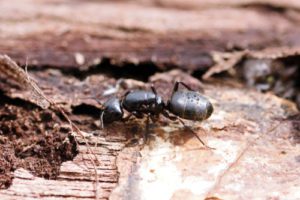
Carpenter Ant. Shutterstock.
If a carpenter ant colony is big enough, active enough, and close enough, you may even be able to hear chewing noises made by the ants’ jaws, especially if the galleries are close to the surface of the infested wood. Some say it is like a rustling or crinkling cellophane sound or even a clicking sound. Note: The larvae of some large wood-boring beetles make a similar noise.
There are usually no outward signs that a piece of wood has been damaged by, or is home to, carpenter ants. There may be a slight warping or blistering of the outer surface but you won’t see the galleries or other evidence unless you break into the infested wood. Solid wood pieces that sound hollow when tapped or wood that is easily penetrated with a knife are signs that there may be carpenter ants within. Note: Wood that is easily penetrated may also be a sign of termite damage or wood rot.
2. WHAT DO CARPENTER ANTS LOOK LIKE?
There are several species of carpenter ants in the Northeast, all belonging to the genus Camponotus. Our main pest species is Camponotus pennsylvanicus, the black carpenter ant. We have other black species and one species that is black with a burgundy middle. Carpenter ant workers are the largest ants that we will see in structures but not all workers are large, they come in a range of sizes from 1/8 up to ½ inch long. The winged reproductive queens are even bigger.
For those of you with a microscope or a magnifying lens, here are some other tips to help ID worker carpenter ants: If you look at a worker ant in profile you would see that its thorax (the large section behind the head) is evenly rounded on top while many ants have a bumpy, uneven thorax. It has one pedicel or node between the thorax and abdomen while many ants have two nodes. There is a circle of hairs around the anal opening at the rear end but no stinger. Although they don’t sting, carpenter ants can bite if threatened.
3. HOW CAN YOU TELL WINGED CARPENTER ANTS FROM WINGED TERMITE SWARMERS?
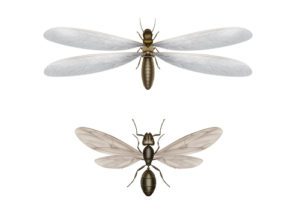
Termite swarmer (top) and Winged Carpenter Ant (below). Shutterstock.
When a colony of either termites or carpenter ants reaches a certain mature size, it produces winged male and female reproductives, called alates, that take flight when conditions are right. The reproductives are generally larger than the workers and look somewhat different – in subterranean termites, reproductives are black in color – but both ant and termite reproductives have two pairs of wings. If swarming indoors, reproductives head towards lights and eventually shed their wings.
You can tell carpenter ant reproductives from termite reproductives by the following characters:
- Ants have wings of two different sizes, with the larger pair in front; termite wings are all the same size.
- Ants have a narrowed “waist” between their thorax and abdomen; termite bodies have no waist indentation.
- Ants have elbowed antennae with a distinct bend; termite antennae are straight and bead-like.
4. WHERE DO CARPENTER ANTS NEST INSIDE?
Carpenter ants prefer to nest in softwoods or hardwoods that have been softened by decay. Nests are most likely to be located in wood that has been damp (moisture level of 20% or higher) because of condensation, plumbing or roof leaks, or wood that repeatedly gets wet such as windowsills. High-risk sites are laundry rooms, around dishwashers, around skylights, garage door framing, chimney flashing, voids behind sinks, under shower or floor drains or under bathtubs, and under insulation in cellars and attics.
Carpenter ants that are nesting indoors are usually members of one or more secondary, satellite colonies that have contact with a main colony outdoors, often living in a dead tree or stump. Once a nest is established indoors in moist wood, carpenter ants may move into dry, sound wood nearby.
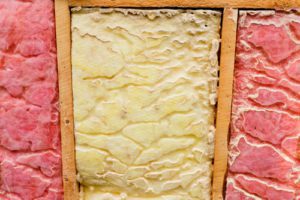
Carpenter Ants Nesting Tunnels inside insulation. Shutterstock.
Indoor satellite nests are not always established in wood though, sometimes ants will set up housekeeping in foam insulation or inside small void spaces instead. Typical void nest sites are inside curtain rods, hollow doors, behind kickplates, in dresser drawers, in hollow ceiling beams, and in false ceilings.
5. HOW CAN YOU TELL CARPENTER ANT DAMAGE FROM TERMITE DAMAGE?
Subterranean termites feed on wood, passing it through their digestive system. Carpenter ants don’t eat the wood that they tunnel into, instead they excavate it to make room for their nest galleries. As they chew into the wood or other material, they will completely remove it from the nest site by pushing it out through slits that they have made in the wood. This is why a pile of what looks like sawdust is often the first sign of a carpenter ant nest.
Because subterranean termites usually travel back and forth from an underground nest, their galleries contain packed soil material that looks like dried mud. Carpenter ant galleries in wood are soil-free and neat and clean with no fecal pellets or frass present. In fact, the galleries look and feel like they have been sandpapered smooth.
Carpenter ant galleries extend along the wood grain and around the annual rings of the wood where they remove the softer springwood first, later removing summerwood to create wider nest galleries, which may contain ant eggs or larvae if the nest is active (see What Does a Carpenter Ant Nest Look Like?).
6. HOW MUCH DAMAGE CAN CARPENTER ANTS CAUSE?
In general, carpenter ant damage is of less economic importance than subterranean termite damage…unless the ant infestation has gone on, overlooked, for some time, usually in buildings that are unoccupied.
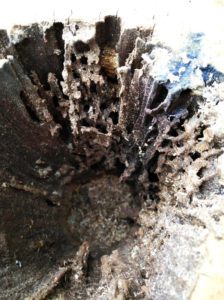
Carpenter Ant damage inside a tree stump. Z. Ciras.
Often, only minor repairs and wood replacement are needed as a result of a typical carpenter ant infestation. Rarely, there may be actual collapse of the infested wood after sudden stress such as a shift of heavy furniture, a wind storm, or heavy snow on a roof.
Since carpenter ants nest most often in wood that is already decaying or has been water-damaged, having to replace it because ants have hollowed it out may not be a big deal. But there is always the possibility that the ants can move into sound wood and do real damage over time.
7. WHAT CAN WE DO TO GET RID OF CARPENTER ANTS?
When dealing with any type of structure-infesting ant, the most important factor in gaining control and eliminating the ants is to find the nest or nests. Carpenter ants may be nesting in a structure or they may just be foraging inside from an outside nest. When carpenter ants are nesting in wood inside, they are usually members of a secondary or satellite colony that has connections to a main colony nest outside.
Carpenter ant treatment is generally a multi-faceted approach (see Carpenter Ants May Require Multiple Approaches). If the ants are just wandering inside, looking for food, our Colonial pest technicians can often eliminate the ants by placing special ant baits along their trails. The foraging ants carry bits of the bait back to the outside nest where toxins in the bait are fed to larvae, other workers, and the queen, eventually destroying the colony.
If the ants are nesting inside, we can usually locate and treat indoor nests without having to open up walls or ceilings using the Microgen micro-injector flusher and crack and crevice applications into the nest site.
You can also discourage carpenter ants around your home by eliminating attractive conditions that provide damp wood (see also Outside Maintenance Can Discourage Carpenter Ants):
1. Fix any indoor plumbing leaks
2. Eliminate condensation and improve ventilation in damp areas
3. Check for rotting wood around the roofline or foundation
4. Remove boards, stakes, etc. from crawlspaces or under porches
5, Make sure downspouts drain away from the foundation
6. Clean out clogged roof gutters
7. Adjust sprinklers so they don’t constantly soak parts of the house
8. Trim tree branches that carpenter ants can use to reach the house
9. Move firewood or lumber piles away from the house
10. Remove stumps or branches on the ground near the house
11. Replace rotting landscape timbers or planter box borders
To keep ants out, we do a thorough exterior pesticide treatment around the foundation and any potential entry points. We recommend that customers that have had carpenter ant issues in the past, sign on for our Preventative Maintenance Program to insure that you get twice annual treatments around the exterior foundation. Best of all, our work comes with a warranty which includes callbacks at no additional charge.